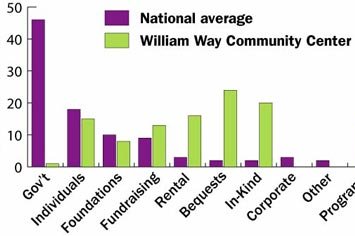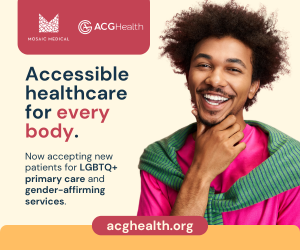A national coalition of LGBT community centers this month released results of a wide-ranging survey that found Philadelphia’s center succeeding in many areas.
CenterLink and Movement Advancement Project’s LGBT Community Center Survey Report gathered data from 79 LGBT centers from across the nation, finding that they collectively served more than 1.7 million people last year.
William Way was one of the oldest in the nation and boasted longer hours, more space and larger staffs and volunteer bases than many similarly situated organizations. While the agency’s revenue was a bit below the national average, the organization relies on more diversified and stabilized means of income.
Although the center’s staff did not include as much diversity as other organizations, the agency was found to serve a diverse cross-section of the city’s LGBT community with a broad range of programs and services.
“Largely, the survey shows that our community center is one of the stronger in the United States,” said center executive director Chris Bartlett. “The strategies put in place over many years here are reaping benefits financially and programmatically and have allowed us to fulfill our mission of meeting the needs of the Philadelphia LGBT community.”
Organization
The center, founded under another name in 1974, is older than most centers. The L.A. Gay and Lesbian Center is the oldest, having opened in 1969, but more than half of the agencies were founded since 1990.
William Way is one of just 13 percent of the centers surveyed that owns its building outright. More than half of the agencies rent their property, and another quarter owns with a mortgage.
“The fact that we own our building gives us tremendous security,” Bartlett said. “But it’s also symbolically important to say that we own our own piece of property that represents the LGBT community in the city. Our community should expect stability after so many years of [predecessor] Penguin Place moving from location to location. To be able to say that we are firmly and stably located at 1315 Spruce St. is very significant.”
William Way’s building came out in front in terms of space, with 29,000 square feet — the average large center offers 17,000 — and hours of accessibility, open an average 68 hours per week, topping the average 50 hours of the rest of the agencies.
Nearly all large centers offer computer services, more than half of which are through the David Bohnett Cyber Center Program, as is William Way’s. The local center provides 11 computers, compared with the average eight at other Bohnett centers, and two printers, as opposed to one at other agencies.
Nationally, about 370 people visit Bohnett centers monthly, although William Way reported about 200 people per month.
Finances
Most centers saw an increase in expenses from 2010-12 — about a 19-percent jump on average — marking a turnaround from the previous survey two years ago that found sharp drops in spending. William Way’s expenses jumped from $835,816 in 2010 to $887,337 the following year, but the 2012 budget predicts $772,655 in expenses.
The center’s 2012 budgeted expenses are lower than the average $1.5 million (which excludes the L.A. center) that large centers reported; however, the revenue is also less.
William Way reported an increase in revenue from $783,399 to $837,177 between 2010-11, accounting for an approximately 7-percent increase, compared with the average 13-percent growth in revenues of the other agencies.
Last year, the large centers on average brought in $1.5 million each.
Bartlett noted that many of the other centers receive funding for HIV services, which the center doesn’t offer.
“When the HIV/AIDS dollars were split up in Philadelphia 15-20 years ago, William Way wasn’t around that table,” he said. “A lot of other centers have HIV/AIDS programs and get a lot of government funding for them, and we don’t. That’s both a plus and a challenge.”
Nationally, large centers relied most heavily on government grants, which comprised 46 percent of their revenue in 2011, followed by individual donations, fundraising and foundational support.
However, William Way’s largest revenue stream last year was bequests, which comprised about 24 percent of total revenue, with about 20 percent from in-kind contributions. Both of these categories amounted to just 2 percent each of the revenue of the other agencies.
Government support accounted for just 1 percent of its revenue last year. The center’s 2011 remaining revenue came from — largest to smallest — rentals, individual donations, foundational support, fundraising and program income.
While Bartlett said the center is interested in pursuing more government support, its reliance on non-governmental sources is vital.
“I’m on the board of CenterLink and when I have conversations with my peers, they have a lot of envy that we have such a strong individual-donor base,” Bartlett said. “Individuals tend to be much less fickle than the government and foundations, and they’re more reliable over decades, where foundations and government sources often change year to year. It’s great that we have such strong support from our individual donors, but the LGBT community in Philadelphia also has the right to expect government support for these services, so that’s something we’re committed to improving.”
Programs
Of its 2011 expenses, the center spent 79 percent on programs, 11 on fundraising and 10 for management and general expenses, figures that were just about on par with other agencies, although the average large center spent more on management than fundraising.
William Way’s programmatic spending was divvied up between social/recreational activities and arts/cultural programs, at 35 percent each, with an additional 10 percent going to information/education, community outreach and mental-health programs.
Nationally, most large centers spent on physical/mental health, followed by information/education, social/recreation, community outreach and arts and culture.
Bartlett explained that Mazzoni Center offers a wealth of LGBT health services so, instead of launching its own health program, William Way has focused on the other programmatic areas.
“We have a wonderful health organization in town so it makes sense for us to focus on all of the other areas of community organizing. They do what they do very well, and we do what we do very well,” he said, noting that both agencies frequently make referrals to the other. “Strong partnerships are key, and allows Mazzoni to have a focused mission on health and us to have a focused mission on what we do well, the arts and cultural and community programming.”
The center’s services were tailored to a number of specific populations, such as parents of LGBT youth, LGBT parents, older adults, men, women and transgender people, although William Way did not report programs geared toward groups like LGBT youth, the HIV/AIDS community, LGBTs of color and homeless individuals.
Similar to the health programming, Bartlett said William Way refers youth programming to such youth-focused agencies as The Attic Youth Center.
He noted that the center is launching a new program geared toward those aged 23-28 who have graduated from The Attic.
Clients
About 200 people access the center’s services per week, and they run the gamut of diversity.
Just about half of the center’s patrons are men, 40 percent are women and the remaining clients identify another way, about on par with the national statistics, as was the 8 percent of clients who identify as transgender.
Fifty-five percent of William Way’s clients are white, 15 percent black, 13 percent Asian and 10 percent Latino, similar to national trends, as were the average ages of the center’s patrons — most are between 36-50, followed by 26-35 and then 51-65.
Most clients at centers across the nation fall below the U.S. average $51,000 household-income threshold, which held true for William Way. Some 29 percent of William Way’s patrons have a household income greater than $60,000. Educational attainment of clients varied greatly among centers, and William Way’s clients trended toward less education.
Forty-three percent of the center’s clients do not have a high-school diploma or GED, while 31 percent do. Twenty-one percent earned some college credits, and 24 percent achieved a bachelor’s degree. About 12 percent attained a post-graduate degree.
Management
William Way is run by a larger staff than most large LGBT centers — more than half of the organizations have fewer than 10 paid staffers, while the local center has 14, six of whom are full-time and eight of whom are part-time.
The center’s staff, however, doesn’t include as much diversity as other agencies. Nationally, more than half of the centers’ staff are people of color, while William Way is staffed by 11 white individuals and three who identify as people of color. The center’s staff is also comprised largely of men, while nationally the breakdown in gender identity is more even.
Bartlett said the center has had a low turnover rate for a number of years, which has inhibited its ability to bring on a more diversified staff.
“One of the things I’m proud of is the stability in staff at the center,” he said. “We’ve only had one staffer who had to leave since I started here and that’s great, but it also means we haven’t hired any new staffers so we keep the same demographics. We need to expand our staff to reflect women, people of color, transgender people. We’re striving to have diversity on the staff, the board and all of our volunteer bodies. That’s strategically a key goal.”
In addition to its staff, the center’s board of 14 members is larger than the average 10 members. The board members equally represent men and women, with one transgender member and about 20 percent who identify as people of color, equal to the national average.
The center’s volunteer base is also larger than other centers’ — large centers reported an average of 171 people who contributed more than 12 hours per week, while William Way amassed 250 volunteers last year.

